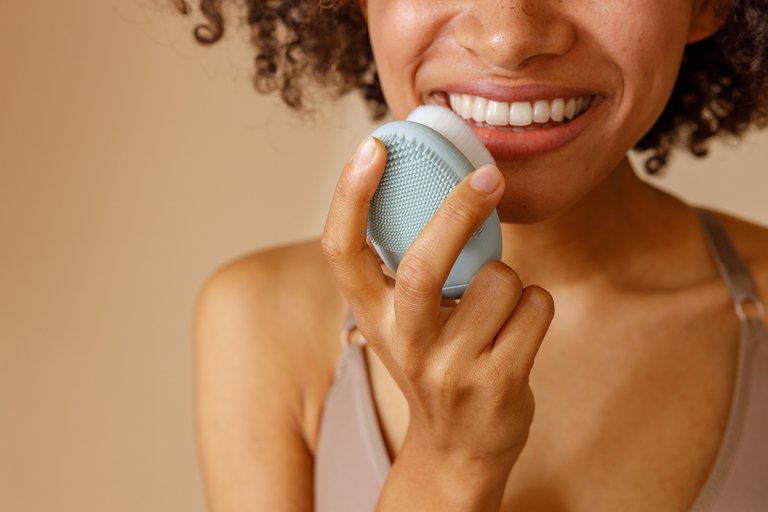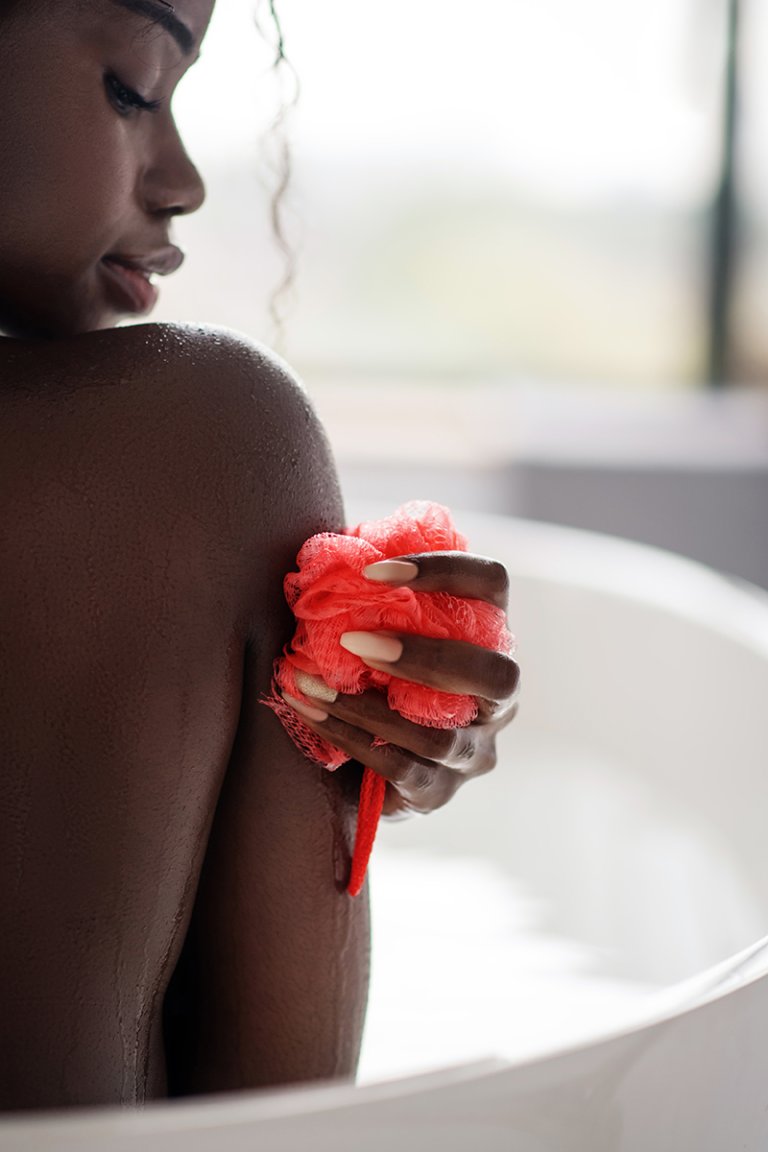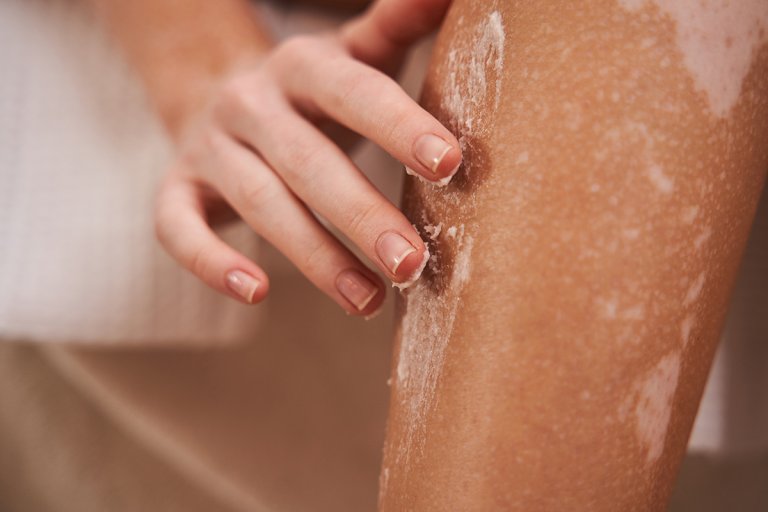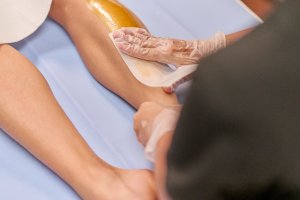Exfoliation, how we do love thee! There are so many benefits to exfoliating the skin on your face and your body. It can help even out your skin tone, unclog pores, prevent acne, and allow all those wonderful moisturizers, serums, and toners to work even better. It can also help you prepare and maintain your skin between waxings.
But what is exfoliation? What does it do? And what place does it have in your beauty and skincare routines?
What is exfoliation?
Exfoliation is like an extra deep clean, and it’s how to get rid of dead skin cells, dirt, bacteria, and excess oil from the surface of your skin. Even if you’re excellent at regular skincare, when you wash your face and body every day, some of that stuff still builds up. That goes for people with any skin type: oily skin, dry skin, or a combo.
You can exfoliate your skin using physical products like a loofah or exfoliating sugar scrub, or by using products that contain chemicals like alpha hydroxy acids and beta hydroxy acids. Some people can even use both!

Why you should exfoliate
Most people know the benefits of cleansers, moisturizers, and sunscreen. But not everyone is as dedicated to exfoliation — or why you should exfoliate at all.
When you don’t exfoliate, dirt and oil can build up on the surface of your skin. That can clog your pores and lead to acne, cause ingrown hairs, and make your skin dry, dull, and uneven. Buffing away those impurities, along with any remaining dead skin cells, can leave your skin clearer, brighter, and healthier looking.
Other benefits of exfoliation include:
- Can help prevent acne
- Allows skincare products to penetrate deeper
- Helps boost circulation and lymphatic drainage
Where does exfoliation fall in my skincare routine?
The order of your skincare routine matters. Here’s where the exfoliants fall in the order of skincare products:
Cleanser
- Exfoliant
- Toner
- Serum
- Moisturizer
- Sunscreen
Should I exfoliate before waxing or shaving?
The short answer is YES. There are lots of benefits of exfoliation in tandem with waxing. But timing is important. Exfoliate too early, and you risk dead skin cells building back up on your skin. Exfoliate too late, and you run the risk of irritation and a potential rash.
Benefits of exfoliation before and after waxing
Exfoliation is an essential pre- and post-wax step. Adding chemical or physical exfoliation sessions between waxes can help open your pores and remove excess sebum and dead skin cells. When you exfoliate regularly, you’ll be prepping the skin in a way that makes waxes more effective and helps prevent ingrown hairs post-wax.
Types of exfoliants
There are two main types of exfoliants: physical exfoliants and chemical exfoliants. You can remove that top layer on your skin using a physical tool or you can use a chemical product to do it for you. If your skin isn’t too sensitive, you can even use both, buffing the skin and then applying a chemical product.
Chemical exfoliation
Certain products contain chemicals — usually either alpha hydroxy acid, beta hydroxy acid, or both — that dissolve the bond between dead skin cells.
Alpha hydroxy acids (AHAs): These include glycolic, citric, and lactic acids and work on the skin’s surface to remove that top layer.
Beta hydroxy acids (BHAs): The most common types of BHAs in skincare are salicylic acid and its derivatives. They’re oil-soluble and penetrate more deeply, making them effective — but they can be a bit harsher. Another option is polyhydroxy acid (PHA), which has larger molecules and is therefore more gentle on the skin.
A note on when to avoid chemical exfoliants:
Chemical exfoliants can make skin extra sensitive, so we’d suggest not using chemical exfoliants at least 2 days prior to waxing and avoiding them within 24 hours after waxing.
Physical (aka mechanical) exfoliation
Physical exfoliation means scrubbing or mechanically buffing your skin with a tool or product that helps slough away all the dead skin, impurities, and oil. Remember that the skin on your body and face are quite different, so don’t use harsh loofahs and body scrubs on your face.
Some physical exfoliants include:
Scrubs that include sugar, powder, seeds, or other gritty ingredients
Loofahs
Exfoliating brushes
Pumice stones
- Dry brushes
It’s best to use physical exfoliants a day or two ahead of a waxing appointment.

Natural exfoliants
Many products use natural ingredients — some of which you may have in your pantry. Some popular natural exfoliants include:
- Finely ground sugar
- Baking soda
- Coffee grounds
- Finely ground almonds
- Oatmeal
- Finely ground sea salt
- Cinnamon
How often should I exfoliate?
Exfoliation is great in moderation, but if you do it too often, your skin can become red and irritated. Even though you use cleansers, moisturizers, and toners every day as part of your beauty and skincare routine, it’s best to start slowly with exfoliants. Aim for 2 to 3 times a week.
Test out whatever method you’re trying and then work up to several times a week — or even daily if it’s a gentle method and your skin tolerates it well. Some serums or cleansers with exfoliants contain lower doses of AHAs and PHAs, so you can use them more regularly.
How to exfoliate safely based on your skin type
Your skin type can help determine the safest and most effective method of exfoliation for you. Here’s how to exfoliate based on your skin type:
1. Skin type: Dry skin
It might seem counterintuitive to exfoliate if you have dry skin, but you want to banish those dry skin cells so they don’t build up. Doing so can help your skin absorb moisture and minimize the appearance of fine lines and wrinkles.
That said, physical exfoliants aren’t the best choice for people with dry skin, because it can cause microtears in your skin and make it red and irritated. Opt for a product that has AHA like glycolic or lactic acid, which you can use daily to help your skin stay clean and bright.
2. Skin type: Oily skin
If you have oily skin, exfoliation is crucial to help prevent oil from building up and causing blackheads, pimples, and clogged pores. A product with salicylic acid (a BHA) works well for those with oily skin, who can tolerate exfoliation the best of any skin type. A gentle facial scrub can also be effective. Even if you have oily skin, you still need to be careful not to overdo it.
3. Skin type: Sensitive skin
People with sensitive skin shouldn’t use a physical exfoliant because it can be too harsh. Look for a chemical exfoliant that contains lactic acid or polyhydroxy acid, both of which can be gentle enough for people with sensitive skin. Start slow — just once a week — to ensure your skin doesn’t react, since it can take a few days for a reaction to occur.
4. Combination skin
If you have combination skin, you might find that your skin is drier in the winter and oilier in the summer. If that’s the case, switch up your routine depending on the season. You can use a product with alpha hydroxy or polyhydroxy acid in the winter and switch to a beta hydroxy acid and occasional scrub in the summer.
If you find that your forehead, nose, and chin are more oily than the rest of your face, you can exfoliate more aggressively in those spots and use a different method for your cheeks. Many people with combination skin can tolerate a wide range of physical exfoliation and chemical exfoliation methods.

We’ve answered the big questions. What is exfoliation? What does exfoliation do? And what are the benefits of exfoliation? Everyone can benefit from regular exfoliation as part of their beauty routines, whether it’s using a loofah twice a week or using a serum with lactic acid on their face before they go to bed. Try a few methods to see what works best for you, and then stick to a routine for clearer, toner, brighter, and more hydrated skin.
And remember: You should stop using exfoliants if your skin is inflamed, peeling, red, or irritated. Avoid exfoliation if you also use certain medications, skincare, or acne products, including retinol and benzoyl peroxide.
Want more? Get the scoop on what’s hot, what’s not, what to try, and what to skip. Find more beauty and skincare articles here.



